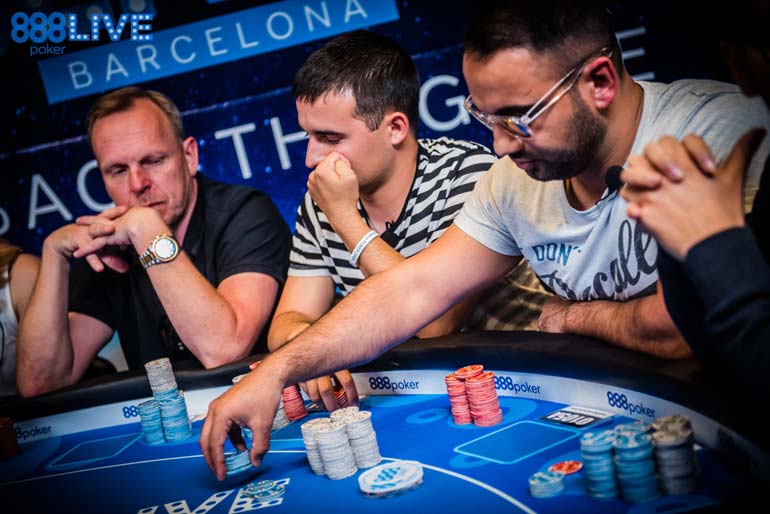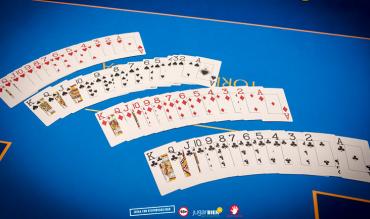There are three mistakes that bad players make and all three are correctible.
Here they are listed below and then provided with a simple plan of correction.
1. They Play Too Many Hands
Their starting high range is too broad – from all positions. They came to the poker room to play; and by golly, they are not about to fold a hand that could turn into a winner. This fact is valid in all positions and on all betting rounds.
Here are some examples:
- Pre-flop middle-position. A couple of players have called the $3 large blind. They have Tc 8d, Ac2s, Qc8c, 4d3d, or Jh3h. They routinely call too.
- Flop. Late position.They called an unraised hand pre-flop with Ks9s. The flop is Ah9h6s. An early position player bets $20. One caller. They are last to act and call.
- River. They are in early position with AhKs. They raised to $12 pre-flop and got two callers. They donk-bet the flop and the turn, for $20 and $35 respectively and got two callers each time. It is now the river. The board is QdJc6s6dKd. They bet $35, get called, and then raised to $70. They call, figuring they are pot committed.
Simply put, they need to tighten their range. Be bold at first. Tighten severely, just to get an entirely different perspective on how to play the game. In early position, narrow to JJ+ and AK, and only play for a raise. In middle and late position, add a calling range of 22+ and suited Aces.
Do not expand it any more than that and see how your game changes.
2. They Play Too Passively
They are calling and not raising. Even with premium holdings, even when they think they have the best or better of it, they are calling and not raising – and seldom initiating the betting. This play is undoubtedly an error for at least two reasons.
- Mediocre players are not getting maximum value out of their best hands.
- And they are letting in opponents who would otherwise fold -- increasing the chances that they will be outdrawn.

Here are some examples of when they should be raising instead of calling.
- Mid and late position, pre-flop with a premium pair, and with the pot raised in front of them. They hold QQ. UTG+2 raises to $10. They just call.Instead, most of the time they should make it $25 or $30.
- Early position, pre-flop with a premium pair and an unraised pot; they should raise. They hold JJ under the gun. They call the $2.They should make it $10 or $12.
- Late position with a strong draw and a few callers in front, they call when they should raise (at least a fair percentage of the time). They hold AhTh and two players call the $2 big blind. They call too. Instead, they should make it $15. They have a few ways to win. They may get all of their opponents to fold or win with a bet on the flop. They may improve and win on the turn or river. They will probably see a flop.
- On the flop, late position, with a strong draw, when it is checked, they too check. Instead, they can bet to win the pot or semi-bluff, with a chance to win with improvement on the turn or river. They have KcQc in the cutoff. After the flop, they are in last position. The flop is 9c9dTc. It is checked to them. They can bet 50-60% of the pot, representing at least two pair and if the rest of the field folds, good. If they get a call or two, they still might improve to a straight or a flush, Kings up or Queens up, and move ahead.
3. They Fail to Concede When Likely Far Behind
There is a time-honoured motto in sports: “Winners never quit, and quitters never win.” While it is a positive way of motivating people on a sports team, it is too often embraced by weak poker players – who fall in love with their hand and refuse to give up. Instead, they need to learn the skill of quitting when they are behind.
Here are two examples of that.
- They have an effective stack of $300 in a $1/2 game and start in late position with AhAc. A few opponents call the big blind, and they raise to $12 and get a couple of callers. The flop is Ks 9s 2c. The action is checked to them, and they bet $25. One opponent calls. The turn is the 2s and their opponent bets $60. They think about folding but conclude that their opponent may be bluffing. And so, they call.
This play is almost always an error. Unless the opponent is a maniac or had them pegged as extremely tight, why would they bet $60 on the turn unless they either hit their flush, trips, or a full house? The better action is to recognise that they were ahead on the deal and possibly the flop with AA, but now they are almost surely behind. With only two outs available to draw a winning hand, they should fold. - They have an effective stack of $150 in a $1/2 game. Holding AhKh in mid-position, they raise the blinds to $10. They are called by a player in late position, raised to $30 by the button and then re-raised to $75 by the big blind. The game has not been especially wild and aggressive, so they call, figuring their AhKh is one of the three best hands in Hold’em.
This call is almost surely an error too. While it is true that AKs ranks exceptionally high on a chart listing powerful pre-flop hands, under the specific circumstances of this hand, it is likely to be dominated by an opponent. While the initial raiser and the 3-bettor may have a pair lower than Kings, and thereby might only be a slight favourite over AK, the odds of the 4-bettor, the 3-bettor, and the raiser all having hands QQ or worse is relatively small.
Add in the fact that one of the raisers may well have an Ace or a King, would kill an out or two for the AK hand. There is also the relatively short stack available after the flop if the hand does hit, and you have a recipe for conceding to the 4-bet.
There are many other mistakes that bad players are likely to make. But if they focused on correcting those listed above, they would be well on their way to winning play.


